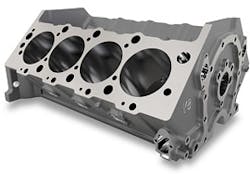Characterizing Cylinder Surfaces at Each Step of the Thermal Barrier Coating Process
Automotive engine manufacturers, seeking to maximize efficiency and reduce emissions, have been using innovative materials and methods to reduce engine weight. One method of reducing weight is to replace the heavy cast-iron cylinder liners, used in aluminum cylinder blocks, with lighter-weight materials that are wear resistant and thermally efficient.
Thermal Barrier Coatings
Instead of using heavy cylinder liners, many manufacturers are turning to Thermal Barrier Coatings (TBC) – a ceramic or composite material applied as a spray to the carefully-prepared walls of the cylinder bores of an aluminum block, and then honed to a final finish with exacting specifications.
To ensure that the TBC performs as designed, precise measurements of a variety of surfaces are required throughout the prep and coating processes.
First, the cylinder walls undergo a mechanical activation process that prepares the surface such that the TBC will adhere properly and enable the sprayed coating to be finished properly. During coating, a splatter morphology occurs, leading to possible inconsistencies in the coating, which must be reliably characterized both before and after final finishing. Finally, the post-spray honing step brings the coating to a very smooth finish and produces a specific cross-hatch pattern which, along with the texture of the spray coating, ensures proper lubricity.
Metrology Requirements
Measuring the cylinder walls at each step of the process requires a versatile metrology system that can measure surfaces ranging from very rough to extremely smooth, including the grooves scored into the surface during the mechanical activation process. ZYGO's 3D optical surface profilers are ideally suited for this task, as they are able to quickly and precisely measure a wide range of surface textures and reflectivities.
While several manufacturers sell optical profilers, only ZYGO optical profilers have a unique and differentiating version of coherence scanning interferometry (CSI) technology. ZYGO CSI delivers sub-nanometer precision at all magnifications, and measures a wider range of surfaces faster and more precisely than other commercially-available technologies. ZYGO optical profilers are robust and field-proven, delivering reliable and repeatable measurements in a production environment, day-in, day-out.
Metrology at Each Step of the Thermal Barrier Coating Process
Learn More About It
For a more in-depth look at the TBC process and how ZYGO precision metrology helps ensure success, be sure to read the article on the Metrology News web site.



